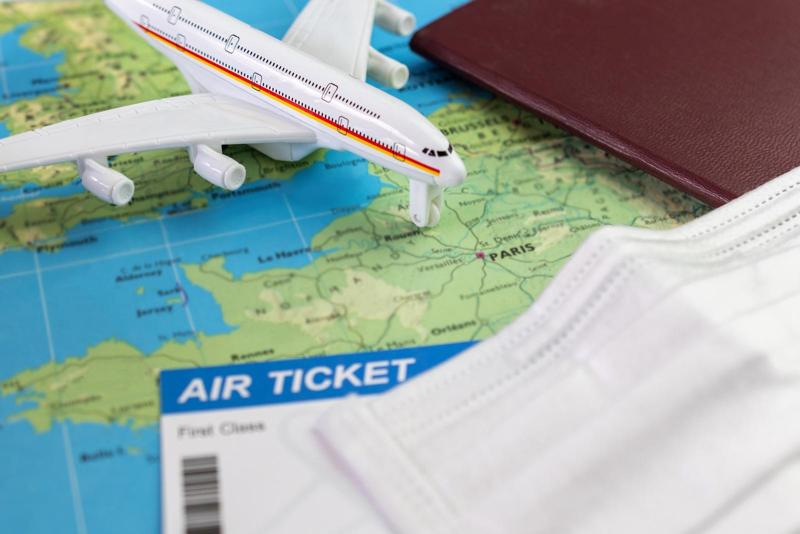France and Italy have long been renowned for their rich cultural heritage, stunning landscapes, and vibrant city life. From the charming streets of Paris to the romantic canals of Venice, both countries offer a wealth of experiences that attract millions of tourists each year.
However, with the ongoing travel restrictions in place due to the global pandemic, exploring these two countries may seem like a distant dream for many travelers. In this article, we will delve into the France travel to Italy restrictions, providing you with a comprehensive guide on how to navigate through them and make the most of your trip.
Before embarking on your journey from France to Italy, it is crucial to understand the current situation regarding travel restrictions imposed by each country. In France, various measures have been implemented to prevent the spread of COVID-19, including mandatory testing and quarantine requirements for incoming travelers. Similarly, Italy has also imposed strict regulations on international travelers entering its borders. By gaining an understanding of these restrictions beforehand, you can ensure a smoother and more enjoyable trip.
As French travelers plan their visit to Italy amidst the travel restrictions, it is important to be familiar with Italy’s specific guidelines and entry requirements. This section will provide a comprehensive guide that covers topics such as visa requirements, health documentation needed for entry, and any additional restrictions or protocols visitors should be aware of. Understanding these details will help you prepare adequately before setting off on your journey across borders.
Despite the challenges posed by travel restrictions between France and Italy, there are still numerous popular tourist spots open for French travelers to explore in Italy. Whether it’s strolling through Rome’s ancient ruins or indulging in fine cuisine in Florence, there are endless opportunities to immerse yourself in the beauty of Italian culture while adhering to safety protocols.
In this article, we will highlight some must-visit destinations that showcase the diversity and allure of Italy while navigating within restricted travel guidelines.
Understanding the Current Situation
The current situation regarding travel to France is crucial for travelers to understand before planning a trip. As of now, France has implemented certain travel restrictions in response to the ongoing COVID-19 pandemic. These measures are aimed at ensuring the safety and well-being of both residents and visitors.
One of the key restrictions imposed by France is the requirement for travelers to present a negative PCR test result taken within 72 hours before their departure. This applies to both French citizens and foreign visitors. Additionally, travelers coming from countries outside of the European Union are required to have essential reasons for their travel, such as family or professional obligations.
Moreover, upon arrival in France, individuals may be subject to health screenings and quarantine measures depending on their country’s risk level. It is important for travelers to stay updated on the latest information provided by the French government and abide by any guidelines or protocols that are in place.
Despite these travel restrictions, it is still possible to explore the cultural charms of France while adhering to safety measures. Many tourist attractions and landmarks such as the Eiffel Tower, Louvre Museum, and Mont Saint-Michel have implemented specific health protocols to ensure a safe experience for visitors. By planning ahead and following all safety guidelines, travelers can make the most out of their time in France even during these challenging times.
| Travel Restrictions | France |
|---|---|
| PCR Test Requirement | Yes (within 72 hours) |
| Essential Reasons for Travel | Required (for non-EU countries) |
| Health Screenings | Possible upon arrival |
| Quarantine Measures | Possible depending on risk level |
Getting to Know Italy’s Travel Restrictions
Italy, with its rich history, breathtaking landscapes, and iconic landmarks, has long been a favorite destination for travelers from around the world. However, due to the ongoing global pandemic and measures implemented to curb the spread of COVID-19, travel restrictions have been put in place. This has made it crucial for potential visitors to understand Italy’s travel restrictions before planning their trip.
To ensure a safe and smooth journey, it is essential for French travelers to familiarize themselves with the current travel restrictions imposed by Italy. Here is a comprehensive guide that outlines the key aspects of Italy’s travel restrictions:
- Entry Requirements: Before embarking on your journey from France to Italy, it is important to be aware of the entry requirements set by Italian authorities. Currently, all travelers entering Italy must fill out a self-declaration form stating their purpose of travel and providing contact information. Additionally, individuals arriving from certain countries may be required to undergo COVID-19 testing or quarantine upon arrival.
- Regional Measures: It is important to note that different regions within Italy may have varying regulations and restrictions in place. Thus, it is crucial for French travelers to stay updated on specific guidelines for the region they plan to visit. This includes understanding any regional lockdowns or curfews that may be in effect.
- Transportation Restrictions: While traveling within Italy, French visitors should also be aware of any transportation limitations that may exist. This includes adhering to capacity limits on public transport and following hygiene protocols such as wearing face masks while onboard.
It is always advisable for French travelers planning a trip to Italy to regularly check with official government websites and consult with their respective embassies for up-to-date information regarding travel restrictions and requirements.
Overall, although experiencing some limitations due to travel restrictions, there are still many beautiful destinations within Italy open for exploration by French travelers. In the next section, we will explore some of the popular tourist spots that are welcoming visitors amidst these restrictions.
Navigating the Entry Requirements
Before embarking on a trip from France to Italy, it is crucial for French travelers to familiarize themselves with the entry requirements set by the Italian government. These requirements are in place to ensure the safety and well-being of both residents and tourists amid the ongoing COVID-19 pandemic. By being aware of these entry restrictions, French travelers can plan their journey more effectively and enjoy a smoother travel experience.
- COVID-19 Testing: All French travelers aged six or above must provide a negative result from a molecular or antigenic test taken within 48 hours before entering Italy. The test results must be presented upon arrival and should be either in English, Italian, French, or Spanish.
- Digital Passenger Locator Form: Prior to traveling, French travelers are required to complete an online digital passenger locator form (dPLF) which collects information about their contact details and recent travels. This form can be accessed through the official website of the Italian Ministry of Health or through dedicated mobile applications.
- Quarantine Requirement: As of now, there is no mandatory quarantine for French travelers arriving in Italy if they meet all the necessary entry requirements mentioned above. However, it is important for travelers to regularly check for updates from both French and Italian authorities as guidelines may change based on the evolving situation.
It is essential for French travelers planning a trip to Italy to stay informed about current entry requirements and any potential changes that may occur in the future. Additionally, it is advisable to consult official sources such as government websites or consulates for accurate and up-to-date information regarding travel regulations between France and Italy. By doing so, French travelers can ensure a hassle-free journey and make the most out of their visit to this stunning Mediterranean country.
Popular Tourist Spots in Italy Still Open for French Travelers
Popular Tourist Spots in Italy
Italy is a country known for its rich history, stunning architecture, and breathtaking landscapes. Despite the travel restrictions in place, there are still several popular tourist spots that remain open and accessible for French travelers. These must-visit destinations offer a glimpse into the beauty and charm of Italy, allowing tourists to immerse themselves in the country’s culture and heritage.
Rome: The Eternal City
One of the top destinations in Italy is Rome, often referred to as the “Eternal City.” Known for its iconic landmarks such as the Colosseum, Roman Forum, and Vatican City, Rome offers a multitude of attractions that cater to all interests.
While some indoor museums and sites may have limited access due to safety protocols, outdoor attractions like the Trevi Fountain and Spanish Steps are open for visitors to enjoy. Additionally, taking a leisurely stroll through Rome’s charming streets or indulging in traditional Italian cuisine at local trattorias can provide a unique experience that embodies the essence of this remarkable city.
Florence: Artistic Renaissance Beauty
Another popular destination in Italy is Florence, a city that showcases an abundance of artistic beauty from the Renaissance era. The city’s historic center is a UNESCO World Heritage site and home to numerous renowned museums and galleries housing priceless works of art.
While certain indoor attractions may have capacity restrictions or require advance reservations, visitors can still explore Florence’s outdoor marvels such as the Piazza della Signoria and Ponte Vecchio. Furthermore, enjoying panoramic views of Florence from Michelangelo’s Square or indulging in authentic gelato while strolling along the Arno River are unforgettable experiences that highlight this enchanting city.
Venice: The City of Canals
No trip to Italy would be complete without a visit to Venice – the floating city renowned for its intricate network of canals and captivating architecture. While some popular attractions like St. Mark’s Basilica or the Doge’s Palace may have limited access, the allure of Venice lies in its charming alleys, picturesque bridges, and romantic gondola rides along the Grand Canal.
Exploring the vibrant neighborhoods of San Marco or Dorsoduro, sampling fresh seafood at local restaurants, and getting lost in Venice’s hidden corners are experiences that allow visitors to truly appreciate the uniqueness and magic of this extraordinary city.
Amidst travel restrictions, these popular tourist spots in Italy continue to offer remarkable sights and experiences for French travelers. It is important to note that regulations and requirements may vary, so it is essential to research and stay updated on any changes before planning a visit. By following safety measures and embracing the beauty of these destinations, French tourists can make the most out of their trip to Italy during these challenging times.
Alternative Experiences for French Travelers
Discovering Hidden Gems in Italy
While popular tourist destinations in Italy may be crowded and restricted due to current travel restrictions, French travelers have the opportunity to explore some hidden gems and off-the-beaten-path attractions. These lesser-known places offer a chance to immerse oneself in the authentic local culture and experience the true essence of Italy. Here are a few recommendations for alternative experiences:
The Amalfi Coast’s Lesser-Known Villages
Instead of heading straight to Amalfi or Positano, consider visiting the lesser-known villages along the Amalfi Coast, such as Atrani or Minori. These picturesque villages offer stunning views, charming streets, and a more laid-back atmosphere compared to their more famous counterparts. Enjoy a leisurely stroll along the narrow alleys, indulge in local cuisine at family-owned trattorias, and relax on quiet beaches away from the crowds.
Bologna’s Hidden Delights
Bologna is often overshadowed by cities like Rome or Florence, but it is a treasure trove of art, history, and gastronomy waiting to be discovered. Explore Piazza Maggiore with its beautiful medieval architecture and climb the Asinelli Tower for panoramic views of the city. Don’t miss out on tasting Bolognese specialties such as tortellini or mortadella at traditional food markets or family-run osterias.
Off-the-Beaten-Path Attractions in France
French travelers who are looking for alternative experiences within their own country can also find plenty of off-the-beaten-path attractions worth exploring. These hidden gems showcase the diverse beauty of France beyond its well-known landmarks. Here are two suggestions:
The lavender fields of Provence
Beyond Provence’s popular cities like Avignon or Aix-en-Provence, the region is blessed with vast lavender fields that offer a unique and soothing experience for travelers. Visit the Plateau de Valensole during the blooming season from June to August and immerse yourself in fields of purple as far as the eye can see. Take a leisurely drive through backcountry roads, visit local lavender farms, and even try your hand at distilling essential oils.
The untamed beauty of Corsica
Corsica, located in the Mediterranean Sea, offers untouched natural landscapes and unparalleled rugged beauty. Explore its stunning beaches like Palombaggia or Roccapina, hike through the mountainous trails of Calanche de Piana, and discover charming hilltop villages like Sant’Antonino. Away from the hustle and bustle of mainland France, Corsica allows French travelers to reconnect with nature and enjoy a sense of tranquility.
By venturing off the beaten path both within Italy and their home country of France, travelers can find hidden gems that offer unique experiences and allow them to avoid crowds while still embracing the beauty of these two incredible destinations.
Making the Most of Restricted Travel
Traveling from France to Italy may currently come with its challenges due to the various travel restrictions in place. However, with some careful planning and preparation, French travelers can still make the most of their trip to Italy. Here are some tips to optimize your journey and ensure an enjoyable travel experience:
- Stay Informed About Travel Restrictions: It is crucial to stay updated on the latest travel restrictions and regulations imposed by both France and Italy. Check government websites, official travel advisories, and reliable news sources regularly to stay informed about any changes or new requirements.
- Plan Ahead and Book in Advance: Due to capacity limits and reduced availability, it is advisable to plan your itinerary and book accommodations, attractions, and transportation in advance. This will help you secure your desired dates and avoid disappointment upon arrival.
- Consider Off-Peak Times: To avoid large crowds and minimize potential health risks, consider traveling during off-peak seasons or weekdays when popular tourist destinations tend to be less crowded. This will allow you to have a more relaxed experience while adhering to social distancing guidelines.
- Explore Lesser-Known Destinations: While popular tourist spots may have stricter measures in place, don’t overlook the charm of lesser-known destinations in Italy. Research hidden gems that are off-the-beaten-path, offering unique cultural experiences while being less crowded.
- Embrace Outdoor Activities: Take advantage of Italy’s beautiful landscapes by engaging in outdoor activities such as hiking, biking, or exploring nature reserves. These activities provide an opportunity for fresh air while maintaining a safe distance from others.
- Follow Health Protocols: Ensure that you adhere to all health protocols throughout your journey, including wearing masks in public places, practicing good hand hygiene, and maintaining social distancing as required by local regulations.
| Tip | Description |
|---|---|
| Stay Informed About Travel Restrictions | Regularly check government websites and reliable news sources for the latest travel restrictions and regulations. |
| Plan Ahead and Book in Advance | To secure accommodations, attractions, and transportation, plan your itinerary and make bookings in advance. |
| Consider Off-Peak Times | Avoid crowds by traveling during off-peak seasons or weekdays when tourist destinations are less busy. |
By following these tips, French travelers can optimize their trip from France to Italy despite the current travel restrictions. Remember to prioritize your health and safety, be flexible with your plans, and embrace the beauty of both countries while adhering to relevant guidelines. With careful preparation and a positive mindset, you can still have an unforgettable experience exploring the cultural charms of France and Italy.
Detailed Safety Measures and Health Protocols
Traveling during a global pandemic requires careful consideration of safety measures and health protocols. As French travelers plan their journey to Italy, it is essential to understand the detailed safety measures and health protocols in place to ensure a secure and worry-free trip.
Firstly, it is crucial for French travelers to be aware of the mandatory requirements before entering Italy. Currently, all travelers aged six or above must provide a negative COVID-19 test result taken within 48 hours before arrival. Additionally, individuals must complete a digital Passenger Locator Form (dPLF) prior to their trip, providing contact information and details on their stay in Italy. Failure to comply with these requirements may result in denied entry.
In terms of general safety measures while in Italy, it is important for French travelers to adhere to the guidelines set by local authorities. These guidelines include wearing face masks in indoor public spaces and maintaining social distancing of at least one meter from others who are not part of the same household. It is also recommended to frequently wash hands with soap and water or use hand sanitizers when soap is not available.
Moreover, it’s essential for French travelers to stay updated on the specific safety measures implemented in different regions of Italy as they might differ slightly depending on the local situation. Some regions may have additional restrictions or requirements in place to control the spread of COVID-19.
By being well-informed about these detailed safety measures and health protocols, French travelers can ensure a secure journey from France to Italy. It is recommended that they regularly check official government websites and consult with travel advisories for the most up-to-date information before embarking on their trip. A responsible and cautious approach will not only safeguard their own health but also contribute towards preventing the spread of COVID-19 between countries.
Future Predictions
As France and Italy continue to navigate the challenges posed by the ongoing pandemic, many individuals are wondering about the future of travel restrictions between these two countries. While it is difficult to predict with certainty, there are several factors that may influence the easing of these restrictions in the coming months.
One important factor that could contribute to the easing of travel restrictions is the vaccination progress in both France and Italy. As more individuals become vaccinated, there is a potential for a decrease in COVID-19 cases, which could lead to a more relaxed approach towards travel. The successful rollout of vaccination campaigns, coupled with declining infection rates, may encourage authorities to consider loosening travel restrictions between France and Italy.
Furthermore, government policies and regulations regarding travel will play a role in determining when and how restrictions are eased. Both France and Italy have been closely monitoring their respective tourism industries, as these sectors have been severely affected by the pandemic. Authorities are keenly aware of the economic benefits that international tourism brings, and they may prioritize reopening borders as soon as it is safe to do so.
However, it is important to note that any predictions regarding easing travel restrictions must be taken with caution. The situation surrounding the pandemic remains fluid, with new variants emerging and infection rates fluctuating. Governments will continue to prioritize public health and safety above all else, meaning that decisions regarding travel restrictions will ultimately be based on the current state of affairs.
Conclusion
In conclusion, while travel restrictions may pose challenges and limitations, it is still possible to embrace the beauty of France and Italy. Despite the current situation, both countries offer a rich cultural experience that shouldn’t be missed. French travelers looking to explore Italy should familiarize themselves with the entry requirements and safety measures to ensure a smooth journey.
Although some tourist spots may be closed or have limited access, there are still plenty of must-visit destinations open for exploration. From the romantic canals of Venice to the historical sites of Rome, there is no shortage of iconic attractions to discover. Additionally, French travelers can also seek out alternative experiences, such as hidden gems and off-the-beaten-path attractions, to avoid crowds and enjoy a more intimate experience with these two remarkable countries.
To optimize their trip, French travelers should consider planning ahead and making necessary reservations in advance. It’s important to stay informed about any changes or updates in travel restrictions between France and Italy before embarking on the journey. By adhering to health protocols and following safety measures implemented by both countries, travelers can ensure a secure and enjoyable visit.
Looking ahead, there is hopeful speculation that travel restrictions between France and Italy may ease in the future. As vaccination efforts progress and case numbers decline, it is possible that both countries will gradually relax their measures. Until then, it’s important for travelers to remain patient and flexible as they navigate these challenging times.
Frequently Asked Questions
Are there Covid restrictions to enter Italy?
Yes, there are Covid restrictions to enter Italy. Currently, Italy requires all travelers, regardless of their nationality or reason for travel, to present a negative Covid-19 test result taken within 48 hours before arrival. This test can be either a molecular or antigenic test.
Additionally, travelers arriving in Italy must fill out a self-declaration form providing information about their travel plans and any possible Covid-19 symptoms they may have experienced in the 14 days prior to travel. It is important to note that these restrictions may change over time, so it is advisable to stay updated with the latest information from official sources before planning any travel to Italy.
Do I need Covid test to enter France from Italy?
As of now, travelers from Italy do not need to present a Covid test to enter France. However, it is essential to keep in mind that the situation can evolve rapidly, and requirements may change depending on the epidemiological situation and government regulations.
Therefore, it is crucial to consult official sources such as the French Ministry of Foreign Affairs or contact relevant consulates or embassies for the most up-to-date information regarding entry requirements for travelers coming from Italy.
What is the current travel advisory for Italy?
The current travel advisory for Italy varies depending on the country issuing the advisory. Many countries have advised against non-essential travel to Italy due to the ongoing Covid-19 pandemic and associated risks.
It is recommended that travelers check their respective government’s advisory website or contact relevant authorities for country-specific guidance regarding travel to Italy. Additionally, it is important to consider local restrictions and guidelines imposed by Italian authorities once in the country, such as mask wearing and social distancing measures which are still in effect across different regions due to varying infection rates.

I’m a passionate traveler, writer, and Italophile. My fascination with Italy’s history, art, and culture has led me on countless adventures across the Italian landscape. Through “I Live Italy,” I share my love for this extraordinary country and aims to inspire others to explore its boundless beauty.





